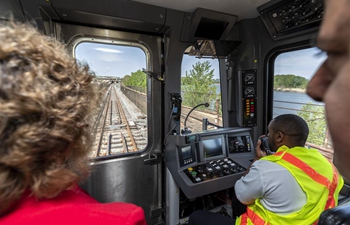WASHINGTON, May 17 (Xinhua) -- Engineers from the Massachusetts Institute of Technology (MIT) have designed a robotic glider that can skim along the water surface, riding the wind like an albatross while also surfing the waves like a sailboat.
The robotic system can cover a given distance using one-third as much wind as an albatross and traveling 10 times faster than a typical sailboat.
In regions of high wind, the robot is designed to stay aloft, much like its avian counterpart. Where there are calmer winds, the robot can dip a keel into the water to ride like a highly efficient sailboat instead.
The glider is also relatively lightweight, weighing about 6 pounds. The researchers hope that in the near future, such compact and speedy robotic water-skimmers may be deployed in teams to survey large swaths of the ocean.
"The oceans remain vastly under-monitored," said Gabriel Bousquet, a former postdoc in MIT's Department of Aeronautics and Astronautics, who led the design of the robot as part of his graduate thesis.
Bousquet will present details of the robotic system next week at IEEE's International Conference on Robotics and Automation, in Brisbane, Australia.
The researchers got inspiration from the bird that can perform a mechanical process called a "transfer of momentum," in which it takes momentum from higher, faster layers of air, and transfers that momentum to lower, slower layers, propelling itself without having to continuously flap its wings.
Bousquet observed that the physics of albatross flight is very similar to that of sailboat travel.
"Sailboats take momentum from the wind with their sail, and inject it into the water by pushing back with their keel," Bousquet said. "That's how energy is extracted for sailboats."
Then the team built a prototype for such a hybrid vehicle and the robotic boat along the river reached about 32 kilometers per hour, at which point the robot autonomously "took off," riding the wind on its own.
"We were flying very close to the surface, and there was very little margin for error. Everything had to be in place," Bousquet said.













